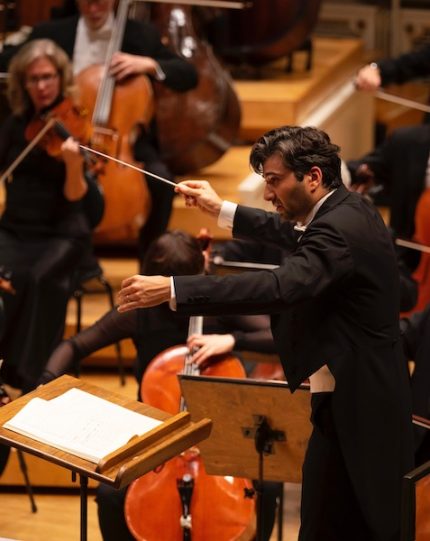Afkham makes an admirable CSO return with Haydn, Strauss and Brahms

While no stranger to Chicago as an assistant to Bernard Haitink, David Afkham made an impressive debut on Chicago Symphony Orchestra subscription concerts three years ago. The young German conductor’s return to Orchestra Hall Thursday night was equally admirable, with Afkham leading a meat-and-potatoes program of Haydn, Strauss and Brahms.
Perhaps the tide is finally beginning to turn for music of Franz Joseph Haydn—for the last fifty years or more the least played of the acknowledged “great” composers. Thursday’s CSO performance of the composer’s Symphony No. 44 was the second Haydn symphony played in town in 48 hours, following Music of the Baroque’s take on his Symphony No. 73 (“La Chasse”).
Anyone in the audience Thursday who believed all of Haydn’s music is cheerful and light-hearted, had that notion quickly dispelled with the “Trauer” (Mourning) symphony, which opened the evening. One of the finest of Haydn’s “sturm und drang” works, No. 44 inhabits a darker landscape, right from the jabbing unison theme that leads off the first movement.
With forces reduced to ideal Haydn scale (just three first-violin stands), Afkham showed a sure hand in this turbulent music, stressing the emphatic accents in the minor-key theme and keeping firm momentum without overdriving the music or inflating the drama out of period. The conductor’s tempo felt a bit measured for the ensuing Menuet’s Allegretto marking, though it underlined the somber mood, the trio providing relief with its gracious warmth.
Haydn supposedly requested that the Adagio be played at his funeral (it wasn’t). While the music is not deeply tragic, Afkham and the strings nicely conveyed its sweet-sad lyric elegance. The concluding Presto was aptly unsettling, performed with biting accents and aggressive intensity.
From Haydn’s “Trauer” symphony to an even more explicitly death-haunted work composed 117 years later, Richard Strauss’s Tod und Verklärung.
Death and Transfiguration was not Strauss’s first tone poem but it was the one that put him on the map. It remains an astonishing achievement for a 25-year-old with whipcrack scoring audacity for huge forces and Strauss’s artistic style already in full mature bloom. Perhaps most striking is the almost clinical musical representation of a dying man’s final minutes—dreams of childhood and salad-day romances flitting by in a semi-conscious state, his eventual demise and post-mortem spirit rising. On his deathbed Strauss wryly commented to his daughter-in-law that dying was just as he had composed it in Tod sixty years earlier.
Afkham led a performance that was focused and atmospheric, the opening section’s timpani and strings reflecting the man’s faltering heartbeat and weakening pulse. Yet this felt very much like a young conductor’s Tod, with Afkham leading a driving, impassioned performance that brought energetic ardor to the joyful reminiscences of childhood and youthful romance.
While the work’s narrative was skillfully charted by Afkham, what was lacking in his forward-pressing style was a feeling of breadth and existential space—especially around the Transfiguration theme’s first appearance and climactic return as the soul rises after death. (The final section could have benefited from more attentive balancing as well.) Still, this was an involving and often affecting performance with especially fine flute contributions by Stefán Ragnar Höskuldsson.
Brahms’ Symphony No. 3 concluded the evening. While the work is, of course, regularly programmed, the Third is the least played of Brahms’ four symphonies: partly for the obvious reason—it ends quietly and the thematic material is somewhat less indelible than in the other symphonies. But the work is also a minefield for conductors with its rapidly shifting tempos and inward-looking music that is not easy to bring off.
Afkham showed himself a largely worthy Brahmsian, investing the opening theme with dramatic swagger and keeping momentum strong in the first movement while giving the varied sections their expressive due. Amid the responsive playing by the orchestra, Stephen Williamson’s oaky clarinet solos stood out, virtually defining Brahms in relaxed rusticity mode.
The inner movements proved somewhat more mixed. The Andante was rushed and impatient, failing to mark sufficient contrast with the opening movement. And in the Poco allegretto, the conductor’s direction felt self-conscious at times, over-moulding phrases that need to sound natural and spontaneous.
The performance was back on track in the closing Allegro, Afkham leading the music with sweep and urgency. Though he allowed the violins’ leading line to get momentarily buried in the long, closing decrescendo, the sense of coming full circle was manifest and the final bars bestowed the right sense of quiet, glowing contentment.
The program will be repeated 8 p.m. Friday and 7:30 p.m. Tuesday. cso.org; 312-294-3000.
Posted in Performances




